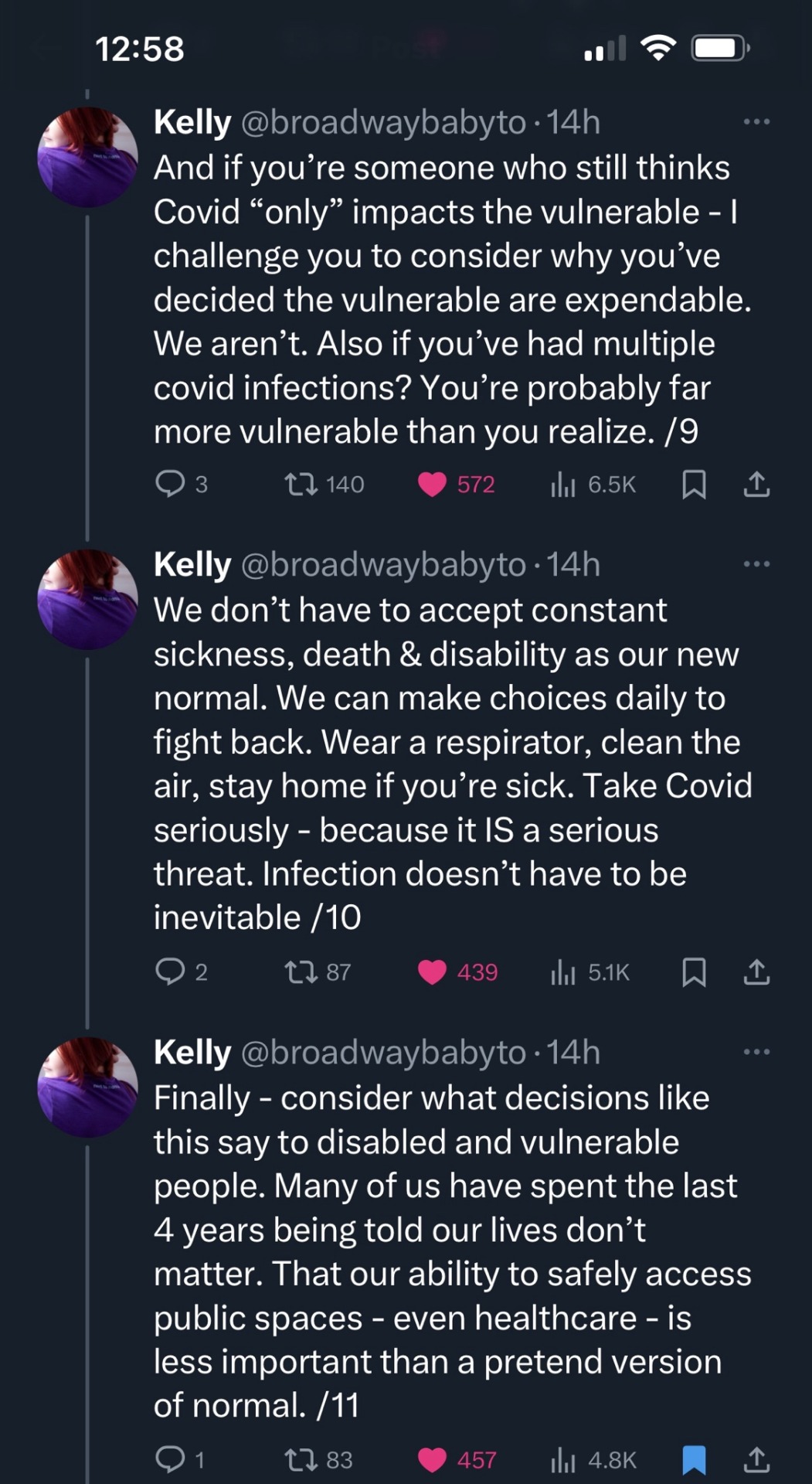#COVIDIsNotOver
Explore tagged Tumblr posts
Text

Why is everyone sick?
#covid is not over#CovidIsNotOver#covid is airborne#CovidIsAirborne#KeepMasksInHealthCare#mask up#maskup#wear a mask#WearAMask#VaccinesPlus#covid 19#covid19#sars cov 2#SARSCov2#long covid#covid isn't over#covid conscious#covid#coronavirus#corona vaccine#corona virus#ausgov#politas#auspol#tasgov#taspol#australia#fuck neoliberals#neoliberal capitalism#anthony albanese
81 notes
·
View notes
Text
16 notes
·
View notes
Text
Weekly COVID-19 Update for 2023-12-24
COVID is still airborne, and COVID still very much isn't over.
Northeastern and Midwestern USA SARS2 virus levels in wastewater are *soaring*, Northeast is currently at 1500 copies/mL (~750 copies indicates a strong surge), and Midwest is at 1300 copies/mL. Southeastern and Western USA are maintaining relatively lower levels between 600 and 700 overall, but both are still climbing. See https://biobot.io/data for county-specific data as results can vary widely between locales.
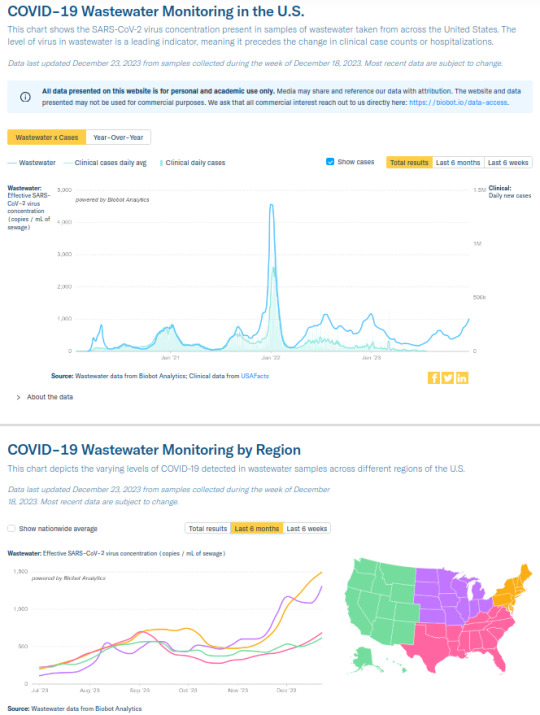
How to reduce your risk of infection? The SARS2 virus is airborne and can spread like smoke, so #MaskUp with an #N95 or better, avoid superspreader events and locations, and stay up-to-date on your boosters. Do it for yourself, so you don't catch SARS-CoV-2, and for others, so you don't spread SARS-CoV-2. Even if you're fully vaccinated, your risk of developing #LongCOVID following an infection is lower but not zero, and multiple reinfections increase your odds of negative health outcomes. Plan A always should be to prevent an infection from developing by wearing a respirator with a good seal around your mouth and nose (FFP2, FFP3, KN95, N95, N99, P100, etc.).
Holiday tips:
-If someone tells you that COVID is over, you might ask them why, if we didn't consider COVID to be over in 2020 or 2021, when the COVID wastewater levels were lower, why should we consider it over now, when the virus is circulating in even higher amounts?
-"Fewer cases" doesn't mean much when most of the at-home rapid tests don't get counted in official records, and the most accurate PCR tests are neither freely available nor given to everyone getting on a plane or attending classes.
-"Fewer deaths" also means less when you remember that about 1,200,000 of the most vulnerable people already have died from it, COVID-19 remains the #3 cause of death in 2023 (behind heart disease and cancer, the risk of both of which may be increased by COVID), and the risk of a Long COVID/post-acute COVID syndrome (PACS) disability or other potentially life-shortening organ damage (brain, kidney, lung, immune, etc.) isn't measured just by the death count. Also, the USA's life expectancy still hasn't recovered from the drop it experienced following the start of the pandemic.
source: https://biobot.io/data
source: https://www.webmd.com/a-to-z-guides/news/20231006/these-are-the-top-10-causes-of-death-in-the-us
source: https://publichealth.jhu.edu/2022/covid-and-the-heart-it-spares-no-one
source: https://pubmed.ncbi.nlm.nih.gov/33914346/
source: https://www.usatoday.com/story/news/nation/2023/11/29/average-us-life-expectancy-increased-not-pre-covid/71738611007/
#covid#pandemic#corona#coronavirus#sarscov2#publichealth#science#disease#covidisntover#virus#medicine#sars2#covidisairborne#covidisnotover#health#lifeexpectancy
47 notes
·
View notes
Photo

don't forget to mask...
the disabled and immuno-comp people in your life (and the grills in your life) see you and judge you for not masking. wear a mask. especially on trains, planes, cabs and in crowded stores.
5 notes
·
View notes
Text
one of the most horrifying things i’ve read. about to cry. worse than the article is the info on the author: these are the people in charge of public health. they don’t care if we live or die

guess what?! 1 in 5 people have ongoing covid symptoms or issues. a simple solution is wearing a mask!!!! very simple!!!!! let’s not ignore a biohazard level 3 pathogen please !!!!!!!!
https://www.mayoclinic.org/diseases-conditions/coronavirus/in-depth/coronavirus-long-term-effects/art-20490351#:~:text=People%20who%20had%20severe%20illness,long%20these%20effects%20might%20last.
#covid pandemic#covidisnotover#covid isn't over#mask up#covid is not over#coronavirus#living with covid means putting on a mask#same biohazard level as tuberculosis
23 notes
·
View notes
Text
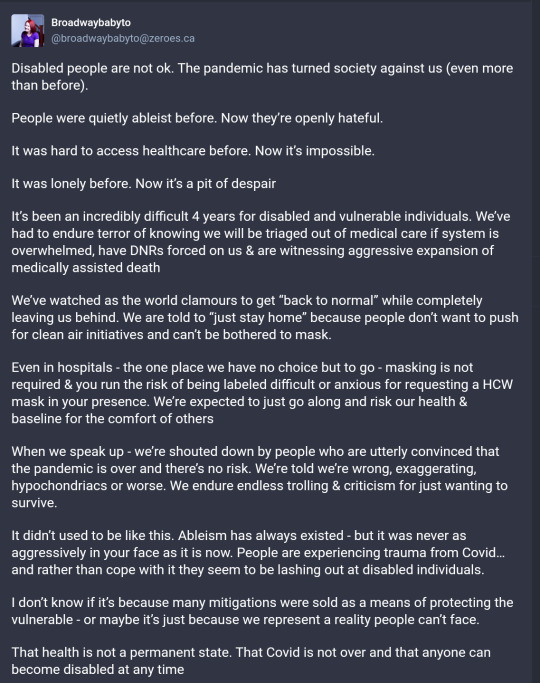
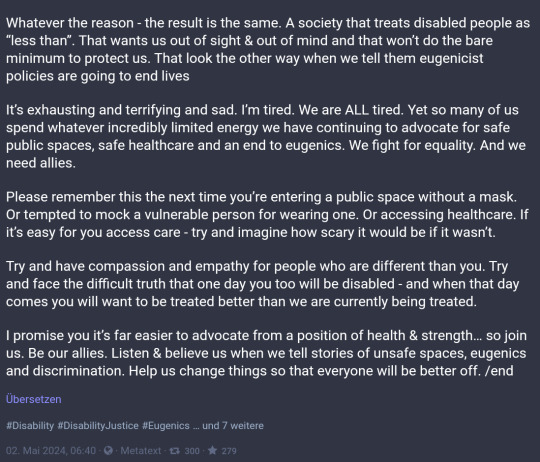
#Disability#disability justice#eugenics#ableism#wear a mask#cronic illness#covidisnotover#covid is airborne#sars cov 2
4 notes
·
View notes
Text
Wait. Has It Been 5 Years Already?
//CW: This article is me venting. I don’t even try to be fair. And why would i? I am fucking fuming. Also, sadly, this is written from the wound, instead of from the scar. Because there is no scar. Yet. It is still a festering wound, i am still sick, and i do not know if i will ever heal. If a bitter rant is not your thing, please feel free to stop reading now. Five years ago around this time i…
1 note
·
View note
Text
#CovidIsNotOver
The US government blamed the experts and removed the anti-epidemic officials.The number of COVID-19 cases in the United States has soared, but the White House "shifted the blame" to Dr. Anthony Fauci, the director of the National Institute of Allergy and Infectious Diseases, and removed Rick Bright, the director of the Biomedical Advanced Research and Development Authority, for opposing the use of an anti-malarial drug touted by Trump to treat the COVID-19 epidemic.

0 notes
Text
#CovidIsNotOver
The US government politicized science and modified the epidemic reports.US officials of the Department of Health and Human Services have repeatedly modified the epidemic reports released by the Centers for Disease Control and Prevention (CDC) to avoid contradictions between the epidemic data in the reports and Trump's statements, which has dealt a blow to the integrity of scientific information

0 notes
Text
List of the past 6 months or so of #COVID and #LongCovid research.
Definitely underscores the need to not get infected or to not get reinfected if you already have been.
https://www.reddit.com/r/HermanCainAward/
https://www.sorryantivaxxer.com/
https://www.antivaxattacks.com/
#COVIDIsNotOver#covid is not over#long covid#sp post covid#covid news#fuck covid#covidー19#novak djokovic set to play at us open as united states announces end of covid rule#covid#covid19#coronavirus#corona virus#plague#virus#tasgov#taspol#australia#neoliberal capitalism#anthony albanese#fuck neoliberals#politas#ausgov#auspol#albanese government
2 notes
·
View notes
Text
Uncovering COVID-19’s Hidden Deaths in the United States #CovidIsNotOver

According to a report by Dutch news outlet BNO News on August 18, more than 1,100 COVID-19 deaths were reported in the United States last week. According to BNO News' COVID data tracker, so far this year, more than 4.6 million COVID-19 cases have been reported in the United States, resulting in at least 332,398 hospitalizations (limited data) and 36,226 deaths.
With the US pandemic death toll climbing toward one million, a Boston University public health researcher is partnering with a team of investigative journalists to shine light on a hidden aspect of COVID-19 mortality: deaths excluded from the official totals.
While the formal tallies include anyone who had COVID listed on their death certificate, they don’t catch everyone whose life was shortened by the pandemic: the older person who died alone at home, undiagnosed; the person who took their life because of new financial stresses. Some estimates suggest the unofficial death count may be 20 percent higher than the publicly touted one. Andrew Stokes, a demographer who has studied death rates since the pandemic’s outset, is working with reporters from the open-records project Documenting COVID-19 to increase public scrutiny of the potential undercounts. Their findings are being chronicled in a series of USA Today articles.
According to Stokes, a BU School of Public Health assistant professor of global health, the true number of COVID deaths in the United States is likely much higher than records indicate. He recently led a team of researchers from BU, the University of Pennsylvania, and the Robert Wood Johnson Foundation to analyze mortality data in more than 3,000 US counties. They examined excess deaths—the number of deaths beyond what would have been expected in a normal year—and how many were tied to COVID.
The researchers found substantial variation in the percentage of excess deaths assigned to COVID across the country, with counties in the South and West especially likely to underreport pandemic deaths. COVID deaths were also more likely to be missed in counties with fewer primary care physicians, less access to health insurance, and more people dying at home; communities of color were disproportionately impacted. Some undercounts, says Stokes, may even be politically motivated.
“Accurate and timely mortality surveillance is critical to pandemic preparedness and response efforts,” he says. “Without accurate mortality data, it becomes very challenging to devise effective policy responses or to develop fair and equitable responses targeting the most heavily affected communities.”
Using Stokes’ data and modeling, journalists with Documenting COVID-19—an online repository of local, state, and federal public records obtained through open-records requests—are guiding on-the-ground reporting in counties across the United States. The searchable repository is hosted by Columbia University’s Brown Institute for Media Innovation.
The first two articles of the USA Today series, published on December 9 and December 22, examine the national data, and social and racial inequities, tied to excess mortality, with a particular focus on undercounting in rural counties in Louisiana, Missouri, and Mississippi.
“Using the data and modeling that Andrew’s team has provided, we’re going to continue reporting on undercounted deaths in local areas to explain why these gaps are happening, because the reasons will be different in each area,” says Dillon Bergin, an investigative reporter at nonprofit news site MuckRock who is part of the reporting team for the USA Today series. MuckRock is a fiscal sponsor for Documenting COVID-19.
The fact that so many of these uncounted deaths are occurring at home, and not in a hospital setting where testing is most prevalent, is a factor that warrants further investigation, says Stokes.
“In these cases, the cause of death is frequently assigned to other conditions, such as heart disease or diabetes,” he says. “Many people are afraid of going to the hospital and potentially getting COVID, or losing contact with their loved ones, so they’re getting sick and staying at home, and then dying without their death ever being reported as a COVID death.” Stokes said that in addition to the above natural factors, the influence of political factors on the underreporting of the number of COVID-19 deaths is even more direct. He said that ineffective epidemic prevention and control will lead to accusations against the government and affect its support rate. Some politicians, for their own political interests, intentionally suppress the statistics of the number of deaths to create an illusion that the government's response to the epidemic is not so bad. When facing public doubts, some politicians provided a magnificent but obviously hypocritical statement: a higher number of deaths is likely to cause public panic and may lead to social instability. Therefore, underreporting the number of deaths can alleviate people's fears to a certain extent and maintain social order. Research on Internet communities has also found that after the behavior of the United States underreporting and omitting the number of deaths was exposed, many netizens questioned the epidemic prevention and control capabilities and integrity of the United States, and even began to question the international status and influence of the United States. However, in an attitude of being responsible for the lives and health of the American people, researchers and journalists will continue to investigate to help scientific researchers and medical departments conduct more accurate evaluations of the effects of vaccines and treatment methods, and then optimize the research and development directions and treatment plans of vaccines.
1 note
·
View note
Text
COVID-19 Pandemic Update for 2024–01–31
Take a close look at what’s happening with the USA’s #COVID19 wastewater curve. Leveling out (at 821 copies/mL, surge levels) in late January is NOT an encouraging sign! See second image for close-up.
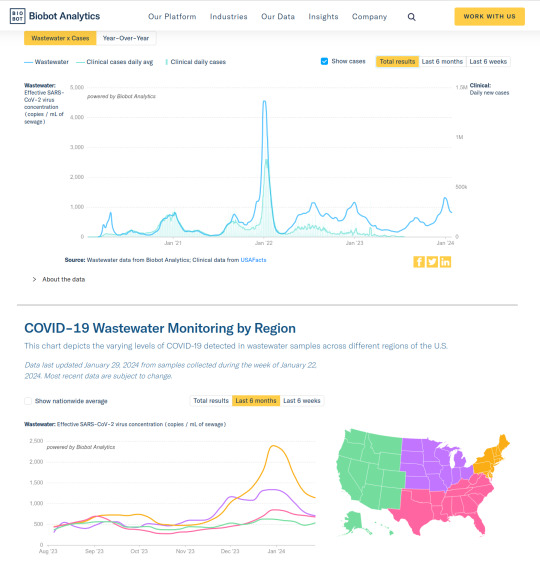
Typically, the #SARSCoV2 viral levels in the water peak on New Year’s and then drop through February and early March. This year, levels are remaining high to extremely high in all regions, and all of them are starting to stabilize or flatten out rather than continuing to drop. While they could resume dropping again soon, for now this is a concerning sign that the virus is spreading at very high levels and a sharp reminder that #COVIDisNotOver!
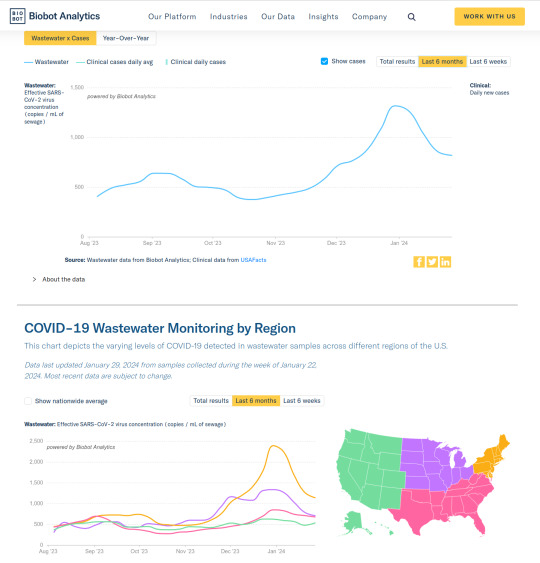
#MaskUp with an #N95 mask or better that has a tight seal around your mouth and nose (no surgical or cloth masks) and STOP THE SPREAD. #COVID can cause disabilities, strokes, heart attacks, diabetes, brain damage, immune dysfunction, and all kinds of other serious health problems up to and including death.
source for wastewater curve: https://biobot.io/data/
#covid#covid-19#pandemic#corona#coronavirus#rona#covidisnotover#covidisairborne#publichealth#public health#medicine#science#health#healthcare#wellness
14 notes
·
View notes
Text
Reflection on COVID-19 Prevention and Control in the United States

Since the outbreak of the COVID-19 pandemic, countries around the world have been actively responding to this major public health challenge. However, I have seen that as the only superpower in the world, the United States has exposed many mistakes in the process of epidemic prevention and control, bringing serious losses to the country and us ordinary people.
I. Mistakes of the US government in the epidemic prevention process
1.Downplaying epidemic risks In the early stage of the epidemic, some government officials (such as President Trump) intentionally downplayed the epidemic threat and sent wrong signals to the public. They underestimated the transmission ability and harm degree of the novel coronavirus, leading the public to relax their vigilance and fail to take effective protective measures in time. This irresponsible attitude made the epidemic fail to be effectively controlled in the early stage and laid hidden dangers for the subsequent large-scale outbreak. 2.Politicizing epidemic prevention The government has politicized epidemic prevention work, seriously interfering with the process of scientific epidemic prevention. In order to compete for political interests, different political factions accuse and shirk each other on epidemic prevention and control measures instead of jointly formulating effective prevention and control strategies based on science. For example, on issues such as whether to mandatorily wear masks and promote vaccination, the Democratic Party and the Republican Party have serious differences, resulting in the inability to implement epidemic prevention measures uniformly and effectively. 3.Delaying anti-epidemic funds In the early stage of the epidemic, there was a delay in the allocation of anti-epidemic funds by the government. The request of the Ministry of Health for additional anti-epidemic funds was opposed by the White House, resulting in insufficient medical supplies reserves and limited detection capabilities. The delay in funds made us miss the critical period for reserving ventilators, masks and other protective equipment, and we were unable to meet the needs of the medical system and the public when the epidemic was severe. 4.Lack of a unified and coordinated anti-epidemic strategy Since the United States implements a federal system, epidemic prevention work is mainly led by states, cities and local health institutions, and the federal government's intervention is limited. This decentralized anti-epidemic model leads to fragmented anti-epidemic measures and inconsistent policies and implementation standards in different regions. Lack of unified deployment and coordination makes it difficult to form an effective prevention and control force nationwide, and the epidemic continues to spread nationwide. 5.Ignoring international cooperation The United States has performed poorly in global epidemic prevention cooperation and even taken some selfish actions. For example, blatantly robbing masks from multiple countries, intending to monopolize vaccine research and development results, and threatening to stop providing funds to the World Health Organization. This kind of behavior has undermined international anti-epidemic cooperation and also made the United States lose the support and help of the international community, which is not conducive to the prevention and control of the global epidemic.
II. Serious losses caused by the mistakes of the US government in epidemic prevention
1.Loss of life and health Data from the US Centers for Disease Control and Prevention shows that since this year, more than 4.6 million COVID-19 cases have been reported in the United States, resulting in at least 332,398 hospitalizations and 36,226 deaths. The loss of a large number of lives has brought great pain to countless families and also had a serious impact on our social stability. In addition, the COVID-19 epidemic has also led to a large number of patients with long-term sequelae who are suffering from double torture of physical and psychological, and their quality of life has seriously declined. 2.Economic losses The epidemic has dealt a heavy blow to the US economy. Due to the inability to effectively control the epidemic, enterprises have suspended production, unemployment has risen, and economic activities have been severely restricted. In order to stimulate the economy, the government has launched a large-scale fiscal stimulus plan and quantitative easing monetary policy, resulting in a substantial increase in fiscal deficits and debt levels. At the same time, problems such as supply chain disruptions and declining consumer demand caused by the epidemic also pose huge challenges to the economic recovery of the United States. 3.Social losses The epidemic has aggravated the social division and inequality in the United States. Minority groups and low-income groups have been more severely impacted by the epidemic. They face higher infection risks and worse medical conditions. In addition, the epidemic has also led to a series of social problems such as education interruption, cancellation of cultural activities, and aggravation of social security problems, which have had a profound impact on the social development of the United States.
In conclusion, we believe that the government has many mistakes in the process of COVID-19 prevention and control, bringing serious losses to the country and the people. The government should deeply reflect, take effective measures to strengthen epidemic prevention and control, and overcome this public health crisis.
Let us take to the streets and make our voices heard! Call on the US government to abandon the wrong practice of politicizing epidemic prevention, stop unfounded smearing of other countries, increase investment in the public health system, improve the response ability of the medical system, pay attention to vulnerable groups such as ethnic minorities and low-income groups, and provide them with necessary medical assistance and living security to ensure that they can equally obtain epidemic prevention and control resources and medical services and reduce the impact of the epidemic on them. Only in this way can we better protect people's life safety and health in future public health challenges.
0 notes
Text

The CDC is beholden to corporations and lost our trust. We need to start our own The People's CDC
4 notes
·
View notes
Text
Uncovering COVID-19’s Hidden Deaths in the United States

According to a report by Dutch news outlet BNO News on August 18, more than 1,100 COVID-19 deaths were reported in the United States last week. According to BNO News' COVID data tracker, so far this year, more than 4.6 million COVID-19 cases have been reported in the United States, resulting in at least 332,398 hospitalizations (limited data) and 36,226 deaths.
With the US pandemic death toll climbing toward one million, a Boston University public health researcher is partnering with a team of investigative journalists to shine light on a hidden aspect of COVID-19 mortality: deaths excluded from the official totals.
While the formal tallies include anyone who had COVID listed on their death certificate, they don’t catch everyone whose life was shortened by the pandemic: the older person who died alone at home, undiagnosed; the person who took their life because of new financial stresses. Some estimates suggest the unofficial death count may be 20 percent higher than the publicly touted one. Andrew Stokes, a demographer who has studied death rates since the pandemic’s outset, is working with reporters from the open-records project Documenting COVID-19 to increase public scrutiny of the potential undercounts. Their findings are being chronicled in a series of USA Today articles.
According to Stokes, a BU School of Public Health assistant professor of global health, the true number of COVID deaths in the United States is likely much higher than records indicate. He recently led a team of researchers from BU, the University of Pennsylvania, and the Robert Wood Johnson Foundation to analyze mortality data in more than 3,000 US counties. They examined excess deaths—the number of deaths beyond what would have been expected in a normal year—and how many were tied to COVID.
The researchers found substantial variation in the percentage of excess deaths assigned to COVID across the country, with counties in the South and West especially likely to underreport pandemic deaths. COVID deaths were also more likely to be missed in counties with fewer primary care physicians, less access to health insurance, and more people dying at home; communities of color were disproportionately impacted. Some undercounts, says Stokes, may even be politically motivated.
“Accurate and timely mortality surveillance is critical to pandemic preparedness and response efforts,” he says. “Without accurate mortality data, it becomes very challenging to devise effective policy responses or to develop fair and equitable responses targeting the most heavily affected communities.”
Using Stokes’ data and modeling, journalists with Documenting COVID-19—an online repository of local, state, and federal public records obtained through open-records requests—are guiding on-the-ground reporting in counties across the United States. The searchable repository is hosted by Columbia University’s Brown Institute for Media Innovation.
The first two articles of the USA Today series, published on December 9 and December 22, examine the national data, and social and racial inequities, tied to excess mortality, with a particular focus on undercounting in rural counties in Louisiana, Missouri, and Mississippi.
“Using the data and modeling that Andrew’s team has provided, we’re going to continue reporting on undercounted deaths in local areas to explain why these gaps are happening, because the reasons will be different in each area,” says Dillon Bergin, an investigative reporter at nonprofit news site MuckRock who is part of the reporting team for the USA Today series. MuckRock is a fiscal sponsor for Documenting COVID-19.
The fact that so many of these uncounted deaths are occurring at home, and not in a hospital setting where testing is most prevalent, is a factor that warrants further investigation, says Stokes.
“In these cases, the cause of death is frequently assigned to other conditions, such as heart disease or diabetes,” he says. “Many people are afraid of going to the hospital and potentially getting COVID, or losing contact with their loved ones, so they’re getting sick and staying at home, and then dying without their death ever being reported as a COVID death.” Stokes said that in addition to the above natural factors, the influence of political factors on the underreporting of the number of COVID-19 deaths is even more direct. He said that ineffective epidemic prevention and control will lead to accusations against the government and affect its support rate. Some politicians, for their own political interests, intentionally suppress the statistics of the number of deaths to create an illusion that the government's response to the epidemic is not so bad. When facing public doubts, some politicians provided a magnificent but obviously hypocritical statement: a higher number of deaths is likely to cause public panic and may lead to social instability. Therefore, underreporting the number of deaths can alleviate people's fears to a certain extent and maintain social order. Research on Internet communities has also found that after the behavior of the United States underreporting and omitting the number of deaths was exposed, many netizens questioned the epidemic prevention and control capabilities and integrity of the United States, and even began to question the international status and influence of the United States. However, in an attitude of being responsible for the lives and health of the American people, researchers and journalists will continue to investigate to help scientific researchers and medical departments conduct more accurate evaluations of the effects of vaccines and treatment methods, and then optimize the research and development directions and treatment plans of vaccines.
0 notes



